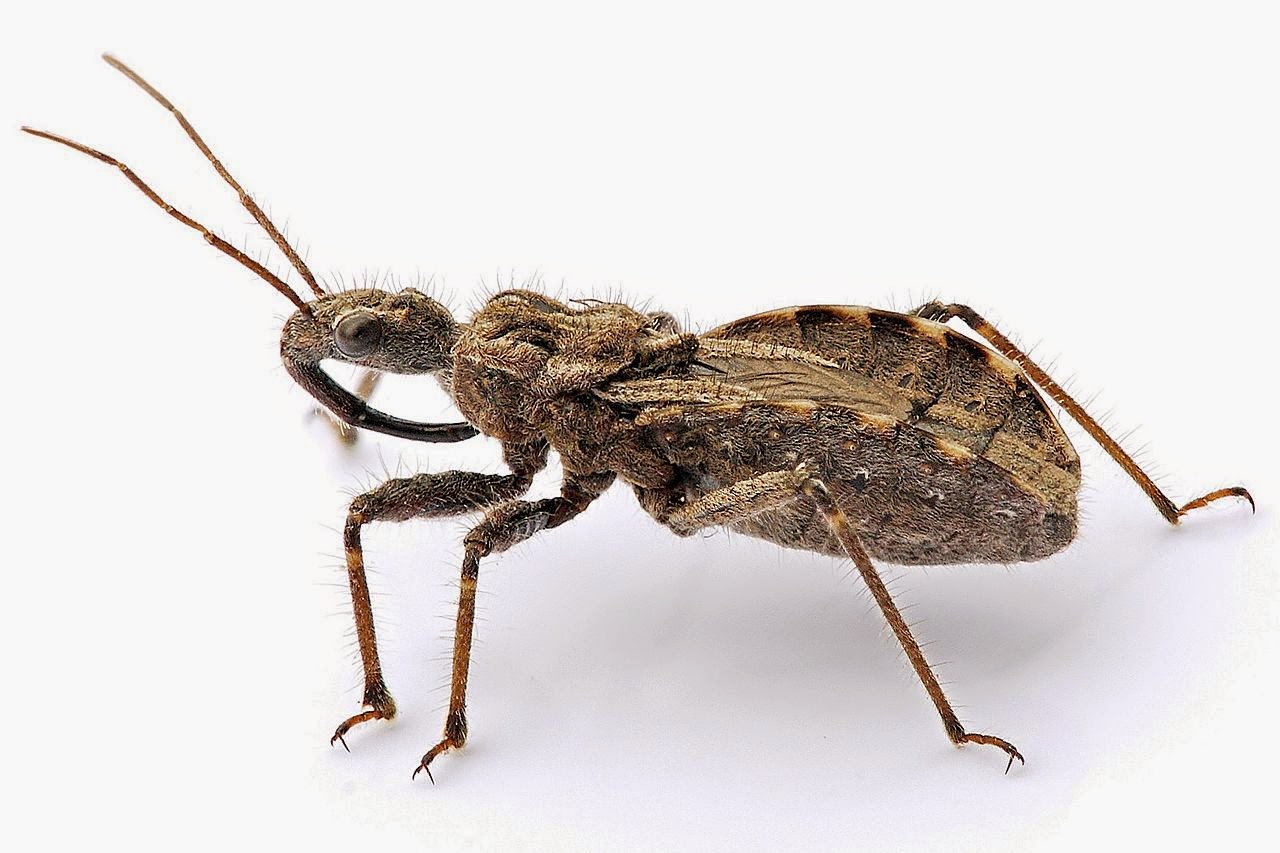Assassin -Kissing Bug Facts
Assassin -Kissing Bug Facts
1. The name ‘bug’ is commonly used for insects that crawl rather than fly. The name is more correctly used to describe members of a large group of insects belonging to the Order Hemiptera. Insects we know as ‘stink bugs’ and ‘shield bugs’ belong to this group.2. These true bugs all feed on the liquid foods they suck up through a movable tube , located on the underside of the head. In the centre of this rostrum are a number of fine needles (stylets) that are used to puncture the surface of the food source.
3. Most Hemiptera feed on plant sap, extracted by piercing and sucking the stems, roots, leaves, bark, fruit or seeds of plants. Many of these plant-feeders live on food plants and become serious pests.
4. There is a great variety of Hemiptera, more commonly known as bugs, in existence. They have evolved an extraordinary range of body forms and lifestyles-some live on land, some live in water, some feed on plants while others are voracious carnivores or scavengers.
5. One large family of these bugs are predatory and feed on the body juices of other animals, mainly other insects. These are called assassin bugs because of their habit of hiding in ambush for their prey. The rostrum of an ordinary plant-feeding bug is tucked flat against the underside of the head, but that of an assassin bug is curved outwards from the head. This is a very useful feature by which to identify predatory bugs. They are able to swing their rostrum forwards as they catch and pierce their prey. Once the prey is held and punctured, a salivary secretion is pumped into a canal running down between the fine stylets. This secretion immobilises the prey and dissolves its internal tissues into a pre-digested ‘soup’ that the assassin bug can then suck up.
6. It is crucial that any food source for bugs has to be liquid for ingestion via the tubular, sucking, mouth parts. Hemiptera have no way of chewing food sources.
7. Although most assassin bugs are slow-moving and non-aggressive, they will use their rostrum in self-defense if handled carelessly.
8. Such bites may be extremely painful to humans because the bugs inject the same salivary secretion used to dissolve the tissues of their prey. This results in the death of a small area of cells at the site of the bite.
9. The symptoms are an intense burning sensation, often followed by a small, itchy lump that may persist for several days. However, no true toxin is involved so it is rare for the reaction to last long or to extend beyond the site of the bite.
10. Chagas (SHA-gus) disease (also called American typanosomiasis [tri-PAN-o-so-MY-ah-sis]) is caused by a protozoan (single celled, microscopic) parasite called Trypanosoma cruzi (tri-PAN-o-so-MA cruise-EYE). The protozoan infects humans and animals through an insect called a “kissing bug” (or “assassin bug”).
11. Animals can get Chagas disease by living or sleeping outside in an area where the “kissing bug” (vector) lives. This bug lives in cracks and holes of old, unkept buildings or homes and wooded areas. The protozoa develops in the intestine of the “kissing bug”. This bug is a blood feeder and will bite its host (animal or human), then excrete feces after feeding. This fecal material contains the protozoa, which then enters the bite wound created by the “kissing bug”.
12. Hemipteran life cycles follow a pattern known as hemimetaboly-rather than larvae they have wing-less nymphs which otherwise resemble the adults to a greater or lesser degree. In other words, the creature resembles a 'proper insect' from birth. The final nymphal stage, which is the fifth instar in Heteroptera, has obvious developed wing buds.
13. Approximately 32,000 Hemiptera species, in 77 families, belong to the Heteroptera. In contrast to other Hemiptera, the Heteroptera include insects which feed not only on sap and other plant material, but also on the haemocoel (the liquid that is equivalent to blood in mammals) of insects and other small arthropods, as well as other animal sources including the blood of mammals and birds.
14. One of the terms used for a lot of Heteroptera is 'stink bugs'. Pick one up, particularly a member of the Coreidae and Pentatomidae families, and they will secrete an unpleasant-smelling substance which might also leave orange or yellow stains on fingers. These secretions come from a pair of glands on the thorax.
15. A lot of assassin bugs camouflage -they are covered in sticky hairs and can shroud themselves in bits of detritus, becoming almost completely invisible, particularly if they are on the bark of trees or on forest floors.
16. Overt aggressors the assasin bugs hunt with bravado, crawling about over plants and over the ground, overpowering any suitable prey. They are strong for their size and able to tackle prey far bigger than they are. Many of them have curious sticky pads on the front legs which aid in securing prey.


I think I have some assassin bug at my place .,. Is there a way to get rid of them?
ReplyDelete